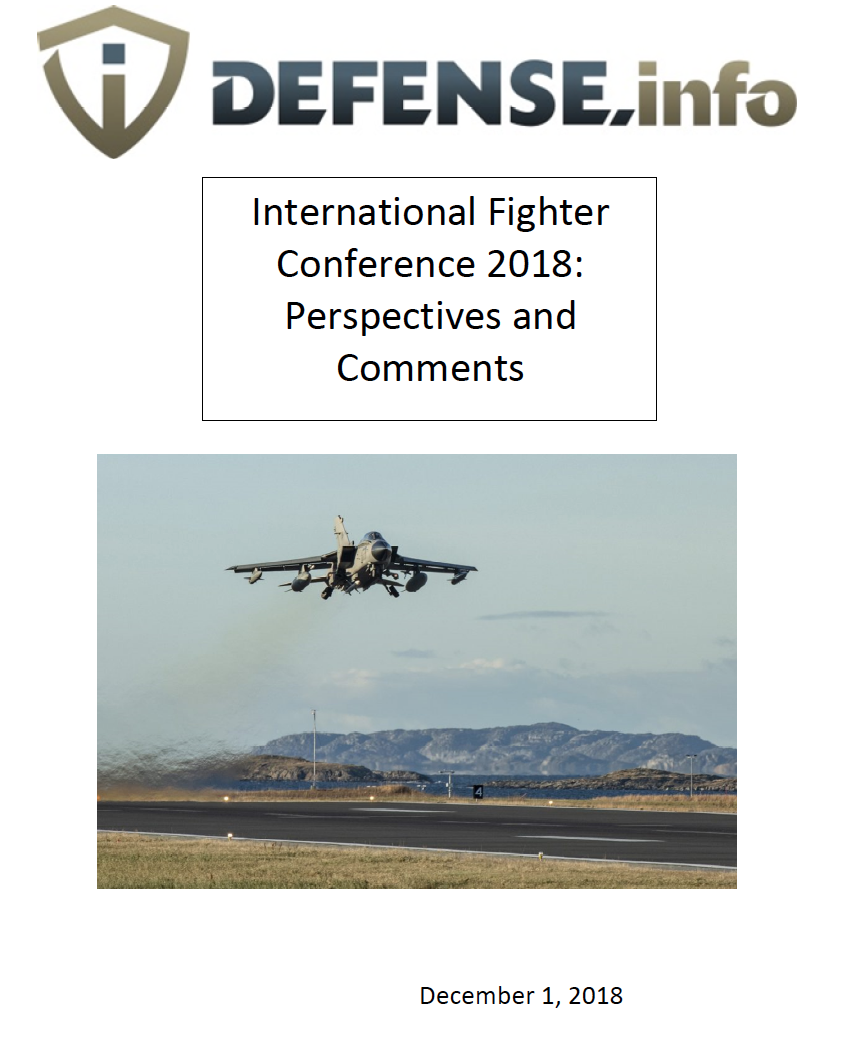Telescoping Generations: The International Fighter Conference 2019 and Its Look at Networked Lethality
When we argued more than a decade ago, that the introduction of fifth generation aircraft would lead to the “Renorming of Airpower,” we had in mind what is clearly occurring now.
Namely, the generations are being telescoped not simply defined sequentially.
The upcoming International Fighter Conference to be held in Berlin from 12-14 November 2019 in effect has gotten to this point with its focus on networked lethality.
There are a variety of approaches to shaping the way ahead for networked lethality and with the presentations to be made at the Conference we will take a look at what those alternative paths might look like.
If you are focused on sequencing you are discussing the 6thgen aircraft; if you are focused on telescoping you are focused on how the air segment of the multi-domain combat force becomes more lethal, survivable and capable of operating as a distributed force.
And the ways to get their reach beyond the question of the next combat air platform: it is about transforming the force to deliver connected force packages able to achieve the tactical and strategic objectives set by the command authority,
This is not classic deterrence – it is about pre-crisis and crisis engagement.
The force we are building will have five key interactives capabilities:
- Enough platforms with allied and US forces in mind to provide significant presence;
- A capability to maximize economy of force with that presence;
- Scalability whereby the presence force can reach back if necessary at the speed of light and receive combat reinforcements;
- Be able to tap into variable lethality capabilities appropriate to the mission or the threat in order to exercise dominance.
- And to have the situational awareness relevant to proactive crisis management at the point of interest and an ability to link the fluidity of local knowledge to appropriate tactical and strategic decisions.
The new approach is one which can be expressed in terms of a kill web, that is a US and allied force so scalable that if an ally goes on a presence mission and is threatened by a ramp up of force from a Russia or China, that that presence force can reach back to relevant allies as well as their own force structure.
The inherent advantage for the US and its allies is the capability to shape a more integrated force which can leverage one another in a crisis.
A shift to a kill web approach to force building, training and operations is a foundation from which the US and its allies can best leverage the force we have and the upgrade paths to follow.1
A kill web linked force allows a modest force package – economy of force – to reach back to other combat assets to provide for enhanced options in a crisis or to ramp up the level of conflict if that is being dictated by the situation.
The evolution of 21st century weapon technology is breaking down the barriers between offensive and defensive systems. Is missile defense about providing defense or is it about enabling global reach, for offense or defense?
Likewise, the new 5th generation aircraft have been largely not understood because they are inherently multi-domain systems, which can be used for forward defense or forward offensive operations.
Indeed, an inherent characteristic of many new systems is that they are really about presence and putting a grid over an operational area, and therefore they can be used to support strike or defense within an integrated approach.
As Ben Werner argued in a recent USNI news piece published on August 7, 2019, the next generation of air dominance will rely on sharing data.
Developing data links to enable existing aircraft to transfer data with forces at sea and on land could prove to be more critical than crafting new platforms for America’s next air war, experts said on Wednesday.
The next generation of air dominance will be a plan that will organize air assets and integrate their abilities into an overall operation involving land, sea, air, space and cyberspace platforms. The key to creating such a system is building capacity for secure data sharing between platforms, service branches and allied nations, said members of a panel speaking Wednesday at the Mitchell Institute.
“The next generation of air superiority is a network-connected family of systems that works together to gather things we need to gather,” said Air Force Maj. Gen. David Krumm, the director of global power programs in the office of the assistant secretary of the air force for acquisition, technology and logistics. “It is not one thing; it is a multiple of things.”
I would argue that this not really next generation as it is usual understood in terms of sequencing of generations, but really is about telescoping to deliver a newly reconfigured and re-crafted combat capability for multi-domain operations.
Warner went on to add comments made during the seminar that really highlight what I think is more about telescoping rather than staying within the older notion of sequencing of generations.
The Pentagon’s next generation of air superiority already has core elements, namely the F-35 Lightning II Joint Strike Fighter. The aircraft can collect tremendous amounts of data, said Marine Corps Lt. Gen. Jon Davis (ret.), a former deputy commandant for aviation.
“Right now the F-35 has incredible sensors,” Davis said. “It is the smartest kid in class and will be the smartest kid in class for some time.”
The military needs the F-35 to share the information it gathers, Davis said. This is an engineering challenge the military is working on solving – how to digest the vast amounts of data collected. The goal is for the F-35 and other aircraft to make each other better shooters, but also make the sea and land forces better shooters he said.
Nearly three years ago, the Navy and Lockheed Martin tested pairing an F-35B with an Aegis Combat System armed with a Raytheon Standard Missile-6. An Aegis test site at the White Sands Missile Range, New Mexico, used data from the F-35 to launch an SM-6 anti-air missile at a Beechcraft MQM-107 target representing an adversarial fighter.
The test was a success and represented how the Navy could expand its Naval Integrated Fire Control-Counter Air concept (NIFC-CA) to include F-35 aircraft. The idea behind NIFC-CA is to connect data from ships and aircraft in a carrier strike group into a network of sensors and shooters. The Navy has been developing NIFC-CA concept for two decades, according to a 2010 Department of Defense report. The NIFC-CA of today has been in the works since 2010 been working to combine multiple systems – as demonstrated in the F-35 test.
On Wednesday, Davis referred to that test saying it’s just one example of how the next generation of air dominance can work.
“Allowing our Navy to be better shooters is something we all have a great interest in,” Davis said. “This airplane allows us to do that.”
The challenge facing the Pentagon is getting the different platforms, especially older ones, to share data with the new platforms such as F-35 aircraft, said Air Force Maj.
Gen. Michael Fantini, the director of air force warfighting integration capability, and the service’s deputy chief of staff for strategy, integration and requirements.
The vision, he said, is for data to be accessible by everyone from anywhere allowing for input from a variety of sources, in much the way Twitter operates.
“We know this is the future because we see it in our everyday lives,” Fantini said.

Personally, I am looking forward to the discussions in Berlin about networked lethality and will report back from the conference as I did last year and then will look at those discussions within the broader evolving context of shaping an integrated distributed force.
The conference will be held from 12-14 November 2019 in Berlin and the program and opportunity to register for the event can be found here:
https://www.defenceiq.com/events-internationalfighter
For a look at some of the arguments and presentations at last year’s conference, see the report below.

